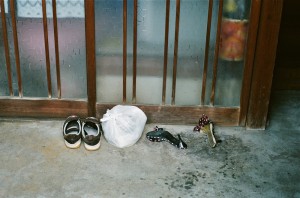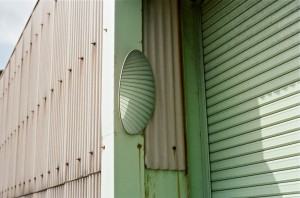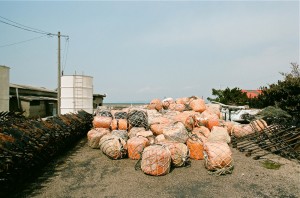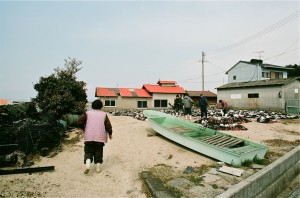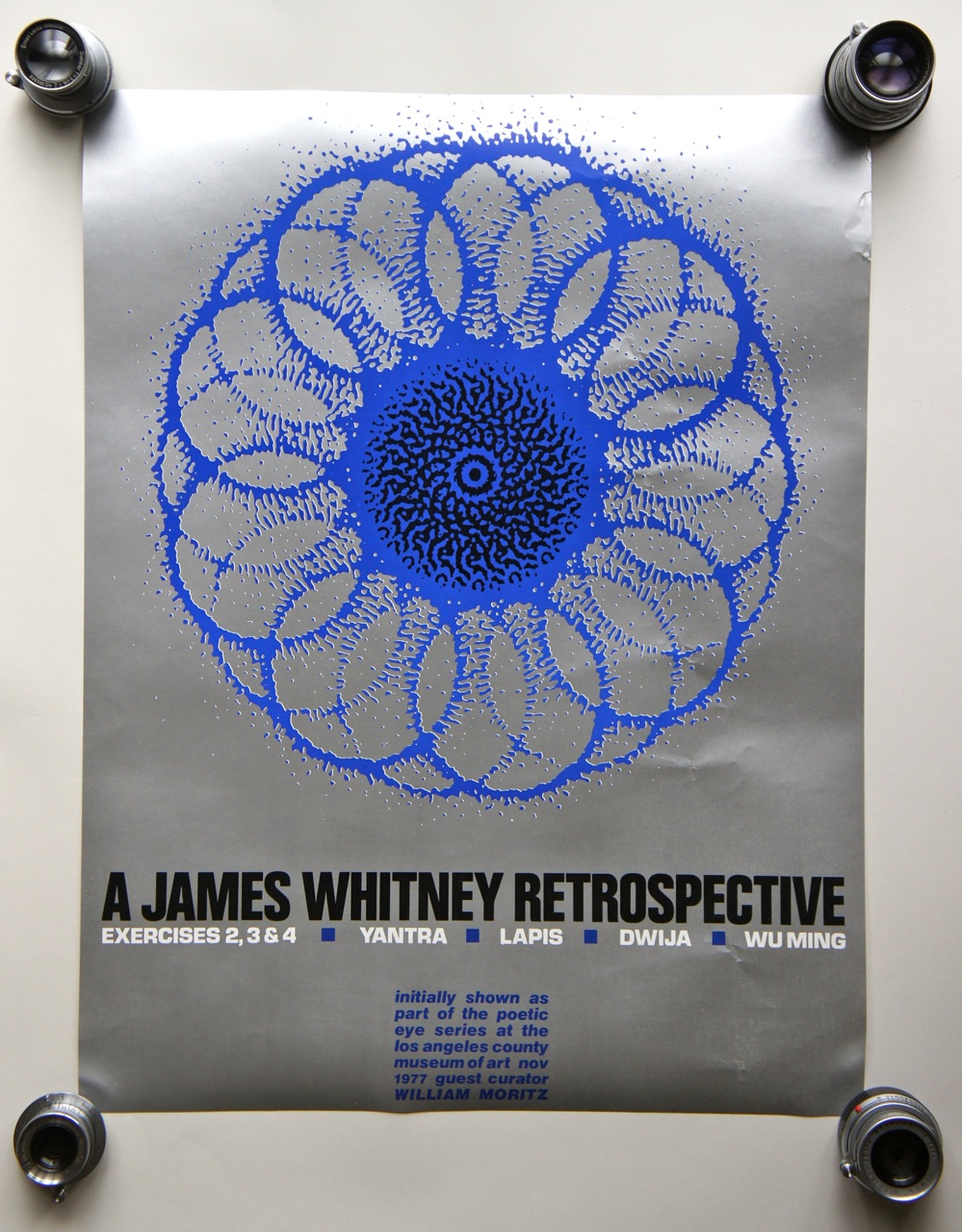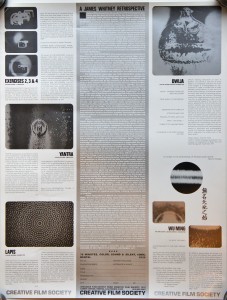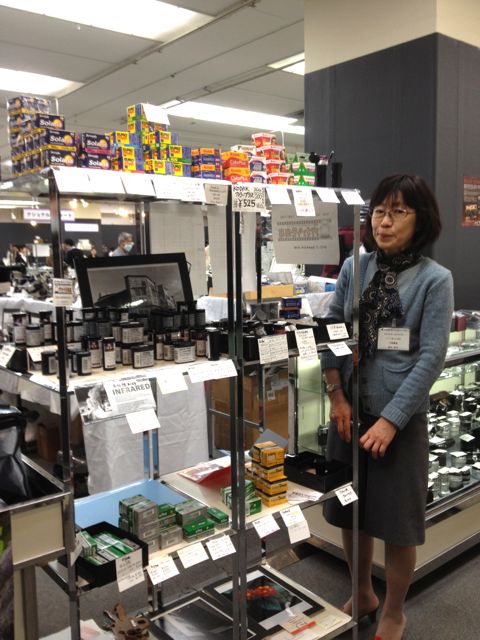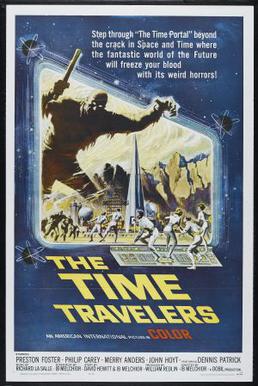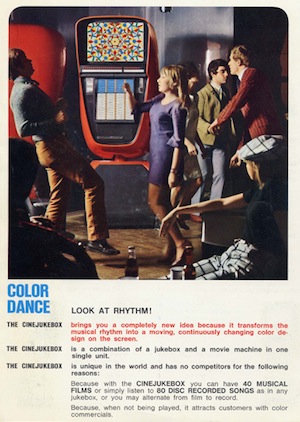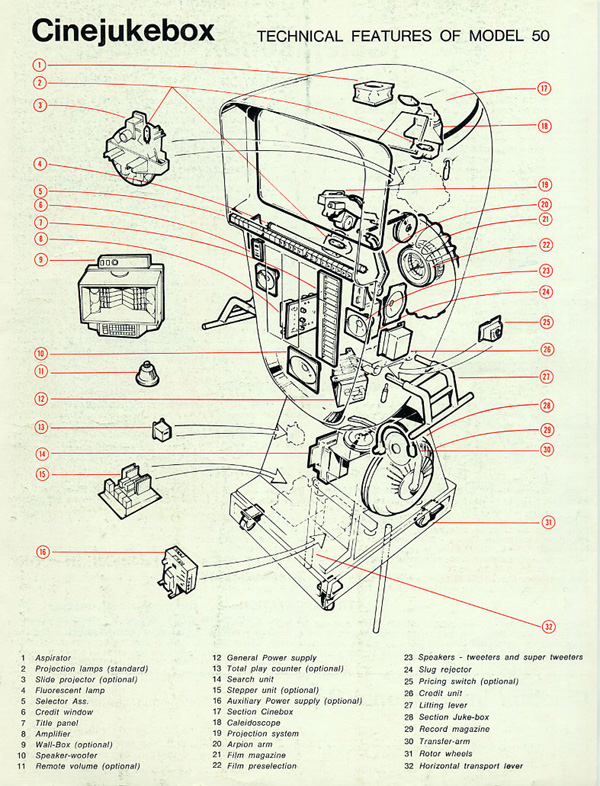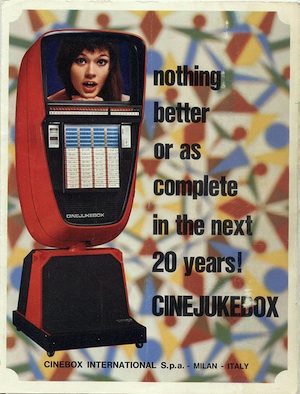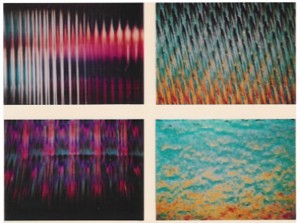Sun Ra filmed by Phill Niblock in the sixties.
Category Archives: Film
Scentsational!
The film I was thinking of this morning was, Polyester (1981) (日本語), not Pink Flamingos, however, these two films have the same the director, John Waters, and main actor (-ess?), Divine, and both are of the cult transgressive genre. The reason that this stuck in my memory for 30 years, is precisely because Polyester features scratch-and-sniff odorama. I remember being intrigued by that prospect but not sufficiently intrigued to take the trouble to see this film, which was usually shown, like other transgressive cult films, starting after midnight. In those days, I was much keener on Neuer Deutscher Film directors like Herzog, Fassbinder, Wim Wenders, and Margarethe von Trotta. I most likely would not have been able to sit through a John Waters film, and the cult transgressive audience of the day would most likely have irritated me. ‘Scratch-and-sniff’ cinema remains an unrealized experience.
I did however spend a couple of years trying to build a mathematical model of the olfactory system and ran a reading/discussion group on the topic of smell when I worked at Caltech. But that is another story.
Der Lauf der Dinge (The Way Things Go)
Der Lauf der Dinge is a 1987 experimental adventure by Swiss duo Peter Fischli and David Weiss.
I♥フィルム Pt.II
(click images for larger size)
More film photos, this time taken with a Nikon FM2 and Nikkor 50mm f1.8, a classic camera and lens both of near-legendary quality, and Kodak Gold 400. This film is one of Kodak’s cheapest offerings but, as you can see, there is nothing cheap about the quality. Some of these scenes should be familiar since they were all taken in Kinugasa, not far from campus.
By the way, when are we going to start making life easier for cyclists? Bicycles have the potential to help solve some of the world’s biggest problems.
I♥フィルム
I always bring both film and digital cameras on my travels. This time I brought only my iPhone 4s, Nikon F3 (HP model) and two lenses Nikkor 24mm f2.8 and Nikkor 50mm f2.0 on my trip to Naoshima. I’ve had the 50/2.0 lens since I bought it new in 1977, when I was 15 years old. These pictures were taken using Kodak Portra 160 film (both NC and new types).
James Whitney Vintage Poster
Films shown in this exhibition included:
- Exercises 2, 3 & 4
- Yantra
- Lapis
- DWIJA
- Wu Ming
The subtitle reads:
Initially shown as part of the poetic eye series of the los angeles county museum of art nov 1977 guest curator WILLIM MORITZ.
There is a description of each film on the verso of the poster.
Poster courtesy of the Center for Visual Music. James Whitney’s films are rather difficult to see these days and would even more difficult to see if not for the CVM, which organizes regular screenings and conducts restoration projects. Thank you CVM and keep up your excellent work!
かわうそ商店:各種フィルムのオンラインショップ
Today, at the annual ICS Antique Camera Fair in Matsuya, Ginza this afternoon, I noticed a new addition to the line up of booths: Kawauso Film shop. They are an online retailer offering a large range of black and white and colour films, as well as other goods for do-it-yourself film photography such as developing tanks and chemicals. This is probably the largest range of unusual films I’ve seen offered by any retailer in Japan. Suzuki-san explained to me that the owner is a photographer living in the Shiretoko peninsula, Hokkaido. Orders, however, are shipped from the Kanto area, so delivery charges are not different from what one would expect for Honshu. Here’s a photo of Suzuki-san with the range of films they were exhibiting at the ICS show:
Suzuki-san is also a film photography enthusiast. She explained to me that Croatian-made Efke films have a larger silver content than is common with current black and white films, so the tonal range is exceptionally good. I’ve used 127 format in ISO 100 in the past and found the film has a tendency to curl, but I decided to buy a roll of Efke ISO 50 in 135 and 120 and give it another try. With enthusiasts like the Kawauso staff and the makers of Efke and Rollei stocks, the future of film photography seems assured. If you have any interest in photography, it is well worth looking at the Kawauso web pages.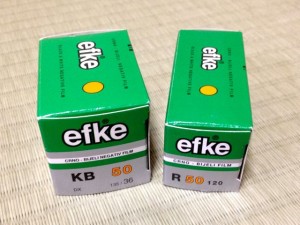
Finally here’s this year’s poster for the ICS show, linked from the ICS web pages.
Oskar Fischinger’s Lumigraph and The Time Travelers
This entry is a postscript to the one on the Cinejukebox, I just want to point out a further example of avant-garde media art technology showing up in a kitsch mass-market setting.
Starting in the late 1940’s animation and visual music pioneer Oskar Fischinger developed a new interface, the Lumigraph, that allowed coloured light to be played expressively in the way one would play a musical instrument. The device did not output sound but was often performed with musical accompaniment. Fischinger hoped to eventually make the Lumigraph available commercially, but as with so many other experimental technologies, this never happened. The following excerpt from the Wikipedia indicates how the Lumigraph was played:
The instrument produced imagery by pressing against a rubberized screen so it could protrude into a narrow beam of colored light. As a visual instrument, the size of its screen was limited by the reach of the performer. Two people were required to operate the Lumigraph—one to manipulate the screen to create imagery, and a second to change the colors of the lights on cue.
This seems to be a very early example of a touch-screen, or at least tactile input device, that are currently changing the way people use computers. I will not write in detail about the Lumigraph today, but it certainly deserves a closer look and I plan a more detailed entry sometime in the future. For the time being, here is Fischinger’s sketch of the Lumigraph (click for larger image on the web site of the Oskar Fischinger Trust):
What I would like to make a note of here is that, as with the music visualizer in the Cinejukebox, the innovative Lumigraph shows up in a highly kitsch cultural offering of the day, Ib Melchior’s 1964 B-grade science-fiction movie, The Time Travelers.
An excerpt from The Time Travelers, with the scene in which the Lumigraph (called Lumichord in the film) appears, is currently on YouTube:
The Lumichord appears in the film as a “love machine” – not part of Oskar Fischinger’s intentions. It appears that the actress does not touch the controls during the performance, which is likely mimed.
There is an account of the Lumigraph, “Writing Light”, by Elfriede Fischinger, wife of Oskar, online at the Center for Visual Music. A short video clip of a 1969 performance on the Lumigraph by Mrs. Fischinger is available on the CVM’s Vimeo channel:
Lumigraph Film (c. 1969) by Elfriede Fischinger (excerpt) from CVM on Vimeo.
[1] William Moritz, Optical Poetry: The Life and Work of Oskar Fischinger, John Libbey Publishing (2004).
For more material about the Lumigraph start with a brief look at the Wikipedia article, then proceed to the materials online at the Oskar Fischinger Trust as well as the Fischinger pages at the CVM.
N.B. None of the images or video clips in this post is hosted by our server. The first resides at the CVM and the second at the Fischinger Trust. Clicking either will open the images on the original sites.
Cinejukebox (1966)
The above image has been on my mind since I first chanced on it a few days ago. The retro-futuristic Ferrari-red semi-egg shaped oddity in this dance club is the Cinejukebox, a deluxe version of the Cinebox, an Italian coin-operated jukebox that played short colour 16mm musical films. The Cinebox, invented in Rome in the late 1950’s and mass-manufactured in Milan during the 1960’s is less well known than the French-produced Scopitone. A recently published book, Canzoni da guardare/Songs to See: Cinebox & Scopitone [1] by Michele Bovi provides evidence the Cinebox has precedence.
Several things fascinate me about the image, taken from a promotional brochure for the Cinejukebox. What initially caught my attention is the kaleidoscopic display on the monitor, the blue sub-title, Color Dance, and the injunctive Look at Rhythm, followed by the claim:
The Cinejukebox brings you to a completely new idea because it transforms the musical rhythm into a moving, continuously changing color design on the screen.
It seems that the Cinejukebox contained a caleidoscopic [sic] projection unit, with separate 12V 100W quartz-iodine lamp. The box also contained separate lamps for the 16mm projector and an optional still projector for showing promotional slides when neither musical films nor records are selected. From the technical brochure:
The amplifier also is equipped with a section for excitation of the visualizer of music during the playing of records, with action which is independent of the volume level generated by the sound control system.
In other words, this is a music visualization system functioning, not acoustically, but most likely via an electro-mechanical actuator driven by the electrical audio waveform. The Cinejukebox was a mid-1960’s version of the earlier Cinebox,with functionality added to allow playing (vinyl) records, like a jukebox. The kaleidoscopic visualizer added graphical activity to the Cinejukebox screen when using jukebox mode.
An aesthetic aspect of the Cinejukebox interests me. While I have not yet been able to see what it looked like in action, the kaleidoscopic visual display is reminiscent of some of John and James Whitney‘s films from the same era (early to mid-1960’s). See, for example, James Whitney’s 1966 16mm short film Lapis. The Whitneys’ experimental animations were (and are) considered to be the height of avant-garde cinema for the day. By contrast, the Scopitone and Cinebox were used to circulate some of the most kitsch visual media humanity has ever seen (more about this in future post). Susan Sontag’s famous essay Notes on Camp [2] described Scopitones as part of a camp canon. How did it come to pass that what was aesthetically experimental media, for its time, made it contemporaneously into technology aimed at mass consumption? In brief, the Cinejukebox appears to be Scopitones and the Whitneys in the same screaming red box. Could this reflect the futuristic techno-utopianism current during the early 1960’s? Was the kaleidoscopic music visualizer evaluated positively by viewers and what impact has it had, if any, on later soni-graphical experiments and technologies? Were there precedents for this kind of audio driven kaleidoscopic display? Further research would be necessary to provide answers for these questions.
Finally, the kaleidoscopic visualizer seems to be related, in concept at least, to an interactive system, the Iamascope, developed by my colleague Prof. Sidney Fels, in the late 1990’s and shown in the Millenium Dome in London during the festivities for the year 2000-2001. It was also demonstrated at NIME-01 held at the Experience Music Project, Seattle.
The pessimist might conclude nothing under the sun is new, while the optimist might answer interesting ideas never die.
[1] Michele Bovi, Canzoni da Guardare/Songs to See: Cinebox & Scopitone (2007). (Accessed 15.02.2012.)
[2] Susan Sontag, Notes on Camp, In: Against Interpretation and Other Essays. New York, Dell (1967).
Jordan Belson, Phenomena
This evening I watched, at a friend’s house, Jordan Belson’s, Phenomena, a 6 minute 16mm colour film he completed in 1965 with fairly primitive equipment. Gene Youngblood, who devoted an entire chapter of his book “Expanded Cinema” [1] to ‘The Cosmic Cinema of Jordan Belson’ wrote:
The essence of cinema is precisely “dynamic movement of form and color,” and their relation to sound. In this respect Belson is the purest of all filmmakers. With few exceptions his work is not “abstract.” Like the films of Len Lye, Hans Richter, Oskar Fischinger, and the Whitneys, it is concrete. Although a wide variety of meaning inevitably is abstracted from them, and although they do hold quite specific implications for Belson personally, the films remain concrete, objective experiences of kinaesthetic and optical dynamism.
Indeed, the fields of colour possess a three dimensional, nearly tangible sense of texture.
There do not seem to be many of Belson’s works available on YouTube. It seems that he felt the quality of streamed video did not do justice to his films. But it is unfortunate that it is so difficult to see his work. I have a DVD with some of the films. Anyone (in the zemi) interested in seeing the DVD, please let me know.
[1] Gene Youngblood, Expanded Cinema, New York, E.P. Dutton & Co. (1970).
Youngblood’s classic book is available online as a PDF file at the Steina and Woody Vasulka online archive of experimental video art. The wikipedia contains an outline of the book.
I recommend having a quick look at the Wikipedia entry about Jordan Belson , then proceeding to the Jordan Belson pages at Center for Visual Music as well as Part III of Gene Youngblood’s book, for more detailed and definitive information.



